Pagoda
A pagoda is a tiered tower with multiple eaves common to China, Japan, Korea, Vietnam and other parts of Asia. Most pagodas were built to have a religious function, most often Buddhist but sometimes Taoist, and were often located in or near viharas. The pagoda traces its origins to the stupa of ancient India.[1][2][3]
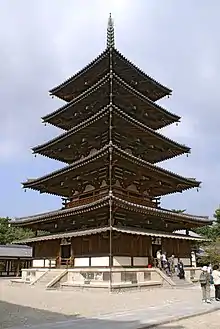

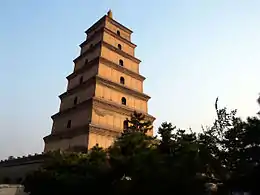
.jpg.webp)
Chinese pagodas (Chinese: 塔; pinyin: Tǎ) are a traditional part of Chinese architecture. In addition to religious use, since ancient times Chinese pagodas have been praised for the spectacular views they offer, and many famous poems in Chinese history attest to the joy of scaling pagodas. The oldest and tallest were built of wood, but most that survived were built of brick or stone. Some pagodas were solid, and had no interior at all. Others were hollow and held within themselves an altar, with the larger frequently containing a smaller pagoda (pagodas were not inhabited buildings and had no "floors" or "rooms"). The pagoda's interior has a series of staircases that allow the visitor to ascend to the top of the building and to witness the view from an opening on one side at each story. Most have between three and 13 stories (almost always an odd number) and the classic gradual tiered eaves.[4][5]
In some countries, the term may refer to other religious structures. In Vietnam and Cambodia, due to French translation, the English term pagoda is a more generic term referring to a place of worship, although pagoda is not an accurate word to describe a Buddhist vihara. The architectural structure of the stupa has spread across Asia, taking on many diverse forms as details specific to different regions are incorporated into the overall design. Many Philippine bell towers are highly influenced by pagodas through Chinese workers hired by the Spaniards.
Etymology
One proposed etymology is from a South Chinese pronunciation of the term for an eight-cornered tower, Chinese: 八角塔, and reinforced by the name of a famous pagoda encountered by many early European visitors to China, the "Pázhōu tǎ" (Chinese: 琶洲塔), standing just south of Guangzhou at Whampoa Anchorage.[6] Another proposed etymology is Persian butkada, from but, "idol" and kada, "temple, dwelling."[7]
Another etymology, found in many English language dictionaries, is modern English pagoda from Portuguese (via Dravidian), from Sanskrit bhagavati, feminine of bhagavat, "blessed", from bhag, "good fortune".
Yet another etymology of pagoda is from the Sinhala word dāgaba which is derived from Sanskrit dhātugarbha or Pali dhātugabbha: "relic womb/chamber" or "reliquary shrine", i.e. a stupa, by way of Portuguese.[8]
History

The origin of the pagoda can be traced to the stupa (3rd century BCE).[3] The stupa, a dome shaped monument, was used as a commemorative monument associated with storing sacred relics.[3] In East Asia, the architecture of Chinese towers and Chinese pavilions blended into pagoda architecture, eventually also spreading to Southeast Asia. The pagoda's original purpose was to house relics and sacred writings.[9] This purpose was popularized due to the efforts of Buddhist missionaries, pilgrims, rulers, and ordinary devotees to seek out, distribute, and extol Buddhist relics.[10]
These buildings (pagoda, stupa) became prominent as Buddhist monuments used for enshrining sacred relics.[3]
China
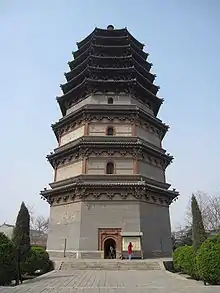
Earliest base-structure type for Chinese pagodas were square-base and circular-base. By the 5th-10th centuries the Chinese began to build octagonal-base pagoda towers. The highest Chinese pagoda from the pre-modern age is the Liaodi Pagoda of Kaiyuan Monastery, Dingxian, Hebei province, completed in the year 1055 AD under Emperor Renzong of Song and standing at a total height of 84 m (275 ft). Although it no longer stands, the tallest pre-modern pagoda in Chinese history was the 100-metre-tall wooden pagoda (330 ft) of Chang'an, built by Emperor Yang of Sui.[11] The Liaodi Pagoda is the tallest pre-modern pagoda still standing, yet in April 2007 a new wooden pagoda at the Tianning Temple of Changzhou was opened to the public; this pagoda is now the tallest in China, standing at 154 m (505 ft).
Symbolism and geomancy
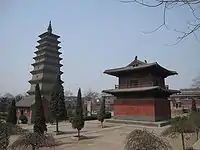
Chinese iconography is noticeable in Chinese pagoda as well as other East Asian pagoda architectures. Iconography of Han is noticeable in architecture of the Chinese Pagoda. The image of the Shakyamuni Buddha in the abhaya mudra is also noticeable in some Chinese pagodas. Buddhist iconography is also inside of the symbolism in the pagoda.[12] In an article on Buddhist elements in Han art, Wu Hung suggests that in these tombs, Buddhist iconography was so well incorporated into native Chinese traditions that a unique system of symbolism had been developed.[13] Some believed they would influence the success of young students taking the examinations for a civil service degree.[14] When a pagoda of Yihuang County in Fuzhou collapsed in 1210 during the Song Dynasty, local inhabitants believed that the unfortunate event correlated with the recent failure of many exam candidates in the prefectural examinations for official degrees, the prerequisite for appointment in civil service.[15] The pagoda was rebuilt in 1223 and had a list inscribed on it of the recently successful examination candidates, in hopes that it would reverse the trend and win the county supernatural favor.[15]
The image of Gautama Buddha in the abhaya mudrā is also noticeable in some Pagodas. Buddhist iconography can be observed throughout the pagoda symbolism.[16] In an article on Buddhist elements in Han dynasty art, Wu Hung suggests that in these tombs, Buddhist symbolism was so well-incorporated into native Chinese traditions that a unique system of symbolism had been developed.[17]
Architecture
Pagodas come in many different sizes,[18] with taller ones often attracting lightning strikes. While this has inspired tradition that the finial decorating the top of the structure can seize demons,[19] the historically frequent damage has often motivated the modern addition of conductive wires connecting the finial to the earth, allowing it to function as a true lightning conductor.[20]
Pagodas traditionally have an odd number of levels, a notable exception being the eighteenth century pagoda designed by Sir William Chambers at the Royal Botanic Gardens, Kew, London.
The pagodas in Myanmar, Thailand, Laos and Cambodia are very different from Chinese and Japanese pagodas. Pagodas in these countries are derived from Dravidian architecture.[21]
Construction materials
Wood

During the Southern and Northern Dynasties pagodas were mostly built of wood, as were other ancient Chinese structures. Wooden pagodas are resistant to earthquakes, however many have burnt down, and wood is also prone to both natural rot and insect infestation.
Examples of wooden pagodas:
- White Horse Pagoda at White Horse Temple, Luoyang.
- Futuci Pagoda in Xuzhou, built in the Three Kingdoms period (c. 220–265).
- Many of the pagodas in Stories About Buddhist Temples in Luoyang, a Northern Wei text, were wooden.
The literature of subsequent eras also provides evidence of the domination of wooden pagoda construction in this period. The famous Tang Dynasty poet, Du Mu, once wrote:
- 480 Buddhist temples of the Southern Dynasties,
- uncountable towers and pagodas stand in the misty rain.
The oldest extant fully wooden pagoda standing in China today is the Pagoda of Fugong Temple in Ying County, Shanxi Province, built in the 11th century during the Song Dynasty/Liao Dynasty (refer to Architecture section in Song Dynasty).
Transition to brick and stone
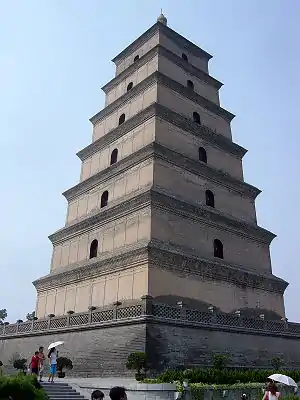
During the Northern Wei and Sui dynasties (386–618) experiments began with the construction of brick and stone pagodas. Even at the end of the Sui, however, wood was still the most common material. For example, Emperor Wen of the Sui Dynasty (reigned 581–604) once issued a decree for all counties and prefectures to build pagodas to a set of standard designs, however since they were all built of wood none have survived. Only the Songyue Pagoda has survived, a circular-based pagoda built out of stone in 523 AD.
Brick
The earliest extant brick pagoda is the 40-metre-tall Songyue Pagoda in Dengfeng Country, Henan.[22] This curved, circle-based pagoda was built in 523 during the Northern Wei Dynasty, and has survived for 15 centuries.[22] Much like the later pagodas found during the following Tang Dynasty, this temple featured tiers of eaves encircling its frame, as well as a spire crowning the top. Its walls are 2.5 m thick, with a ground floor diameter of 10.6 m. Another early brick pagoda is the Sui Dynasty Guoqing Pagoda built in 597.
Stone
The earliest large-scale stone pagoda is a Four Gates Pagoda at Licheng, Shandong, built in 611 during the Sui Dynasty. Like the Songyue Pagoda, it also features a spire at its top, and is built in the pavilion style.
Brick and stone
One of the earliest brick and stone pagodas was a three-storey construction built in the (first) Jin Dynasty (265–420), by Wang Jun of Xiangyang. However, it is now destroyed.
Brick and stone went on to dominate Tang, Song, Liao and Jin Dynasty pagoda construction. An example is the Giant Wild Goose Pagoda (652 AD), built during the early Tang Dynasty. The Porcelain Pagoda of Nanjing has been one of the most famous brick and stone pagoda in China throughout history. The Zhou dynasty started making the ancient pagodas about 3,500 years ago.
De-emphasis over time

Pagodas, in keeping with the tradition of the White Horse Temple, were generally placed in the center of temples until the Sui and Tang dynasties. During the Tang, the importance of the main hall was elevated and the pagoda was moved beside the hall, or out of the temple compound altogether. In the early Tang, Daoxuan wrote a Standard Design for Buddhist Temple Construction in which the main hall replaced the pagoda as the center of the temple.
The design of temples was also influenced by the use of traditional Chinese residences as shrines, after they were philanthropically donated by the wealthy or the pious. In such pre-configured spaces, building a central pagoda might not have been either desirable or possible.
In the Song Dynasty (960–1279), the Chan (Zen) sect developed a new 'seven part structure' for temples. The seven parts—the Buddha hall, dharma hall, monks' quarters, depository, gate, pure land hall and toilet facilities—completely exclude pagodas, and can be seen to represent the final triumph of the traditional Chinese palace/courtyard system over the original central-pagoda tradition established 1000 years earlier by the White Horse Temple in 67. Although they were built outside of the main temple itself, large pagodas in the tradition of the past were still built. This includes the two Ming Dynasty pagodas of Famen Temple and the Chongwen Pagoda in Jingyang of Shaanxi Province.
A prominent, later example of converting a palace to a temple is Beijing's Yonghe Temple, which was the residence of Yongzheng Emperor before he ascended the throne. It was donated for use as a lamasery after his death in 1735.
Styles of eras
Han Dynasty
Examples of Han Dynasty era tower architecture predating Buddhist influence and the full-fledged Chinese pagoda can be seen in the four pictures below. Michael Loewe writes that during the Han Dynasty (202 BC – 220 AD) period, multi-storied towers were erected for religious purposes, as astronomical observatories, as watchtowers, or as ornate buildings that were believed to attract the favor of spirits, deities, and immortals.[23]
 Ancient Chinese model of two residential towers, made of earthenware during the Han Dynasty, 2nd century BC to 2nd century AD, excavated by archaeologists in 1993
Ancient Chinese model of two residential towers, made of earthenware during the Han Dynasty, 2nd century BC to 2nd century AD, excavated by archaeologists in 1993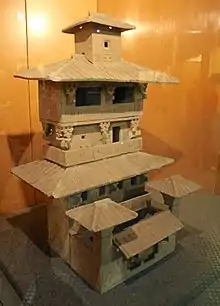 Side view of a Han pottery tower model with a mid-floor balcony and a courtyard gatehouse flanked by smaller towers; the dougong support brackets are clearly visible.
Side view of a Han pottery tower model with a mid-floor balcony and a courtyard gatehouse flanked by smaller towers; the dougong support brackets are clearly visible. A Western-Han model of a watchtower with human figures on its balconies (including crossbowmen) and a gatehouse and courtyard on the first floor
A Western-Han model of a watchtower with human figures on its balconies (including crossbowmen) and a gatehouse and courtyard on the first floor Among a large set of architectural models, three Eastern Han Dynasty watchtowers stand in the rear of this display
Among a large set of architectural models, three Eastern Han Dynasty watchtowers stand in the rear of this display
Sui and Tang
Pagodas built during the Sui and Tang Dynasty usually had a square base, with a few exceptions such as the Daqin Pagoda:
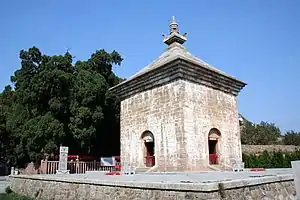 Four Gates Pagoda, built in 611.
Four Gates Pagoda, built in 611. The Daqin Pagoda, built in 640.
The Daqin Pagoda, built in 640.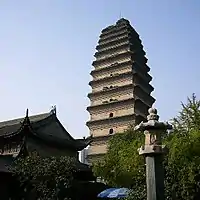 The Small Wild Goose Pagoda, built in 709.
The Small Wild Goose Pagoda, built in 709.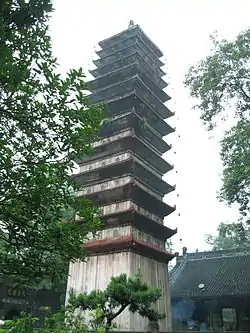 Pagoda of the Baoguang Temple, built between 862 and 888.
Pagoda of the Baoguang Temple, built between 862 and 888.
Dali kingdom
 The Three Pagodas, 9th and 10th centuries.
The Three Pagodas, 9th and 10th centuries.
Song, Liao, Jin, Yuan
Pagodas of the Five Dynasties, Northern and Southern Song, Liao, Jin, and Yuan Dynasties incorporated many new styles, with a greater emphasis on hexagonal and octagonal bases for pagodas:
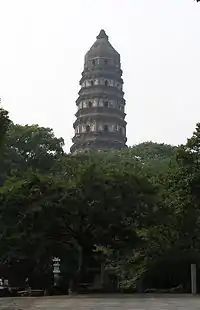 The Huqiu Tower, built in 961.
The Huqiu Tower, built in 961.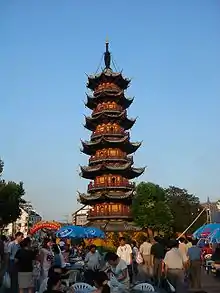 Longhua Pagoda, built in 977.
Longhua Pagoda, built in 977. Pagoda of Fogong Temple, built in 1056.
Pagoda of Fogong Temple, built in 1056. The Liaodi Pagoda, built in 1055
The Liaodi Pagoda, built in 1055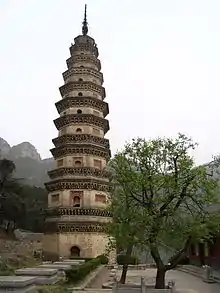 Pizhi Pagoda, built by 1063.
Pizhi Pagoda, built by 1063.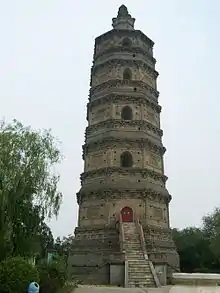 Haotian Pagoda, built in 1103.
Haotian Pagoda, built in 1103.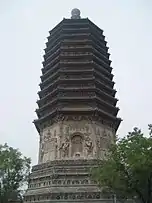
 The Chengling Pagoda, built in 1189.
The Chengling Pagoda, built in 1189.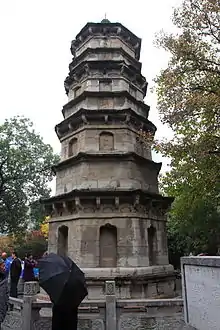 Wuying Pagoda, built in 1270.
Wuying Pagoda, built in 1270. Pagoda of Bailin Temple, built by 1330.
Pagoda of Bailin Temple, built by 1330.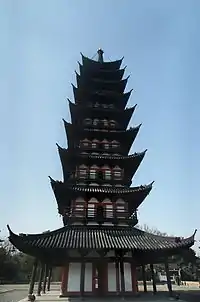 The Square Tower of Songjiang, Shanghai, built in 1884.
The Square Tower of Songjiang, Shanghai, built in 1884.
Ming and Qing
Pagodas in the Ming and Qing Dynasties generally inherited the styles of previous eras, although there were some minor variations:
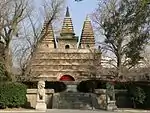 Zhenjue Temple, built in 1473.
Zhenjue Temple, built in 1473.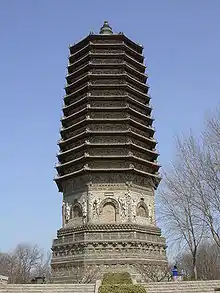 The Pagoda of Cishou Temple, built in 1576.
The Pagoda of Cishou Temple, built in 1576. The Sarira Stupa of Tayuan Temple, built in 1582
The Sarira Stupa of Tayuan Temple, built in 1582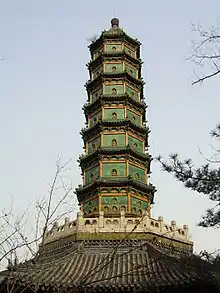 The Fragrant Hills Pagoda, built in 1780.
The Fragrant Hills Pagoda, built in 1780.
Some notable pagodas
Tiered towers with multiple eaves:
- Dâu Pagoda, Bắc Ninh, Vietnam, built in 187.
- Pashupatinath Temple, Kathmandu, Nepal built in the 5th century.
- Trấn Quốc Pagoda, Hanoi, Vietnam, built in 545.
- Songyue Pagoda on Mount Song, Henan, China, built in 523.
- Mireuksa at Iksan, Korea, built in the early 7th century.
- Bunhwangsa at Gyeongju, Korea, built in 634.
- Xumi Pagoda at Zhengding, Hebei, China, built in 636.
- Daqin Pagoda in China, built in 640.
- Hwangnyongsa Wooden nine-story pagoda on Hwangnyongsa, Gyeongju, Korea, built in 645.
- Pagoda at Hōryū-ji, Ikaruga, Nara, Japan, built in the 7th century.
- Giant Wild Goose Pagoda, built in Xi'an, China in 704
- Small Wild Goose Pagoda, built in Xi'an, China in 709.
- Seokgatap on Bulguksa, Gyeongju, Korea, built in 751.
- Dabotap on Bulguksa, Gyeongju, Korea, built in 751.
- Tiger Hill Pagoda, built in 961 outside of Suzhou, China
- Lingxiao Pagoda at Zhengding, Hebei, China, built in 1045.
- Iron Pagoda of Kaifeng, built in 1049, during the Song dynasty.
- Liaodi Pagoda of Dingzhou, built in 1055 during the Song dynasty
- Pagoda of Fogong Temple, built in 1056 in Ying County, Shanxi, China.
- Pizhi Pagoda of Lingyan Temple, Shandong, China, 11th century.
- Beisi Pagoda at Suzhou, Jiangsu, China, built in 1162.
- Liuhe Pagoda of Hangzhou, built in 1165, during the Song dynasty.
- Ichijō-ji, Kasai, Hyōgo, Japan, built in 1171.
- The Porcelain Tower of Nanjing, built between 1402 and 1424, a wonder of the medieval world in Nanjing, China.
- Tsui Sing Lau Pagoda in Ping Shan, Hong Kong, built in 1486.
- Dragon and Tiger Pagodas in Kaohsiung, Taiwan, built in 1976.
- Seven-storey Pagoda in Chinese Garden at Jurong East, Singapore, built in 1975.
- Pazhou Pagoda on Whampoa (Huangpu) Island, Guangzhou (Canton), China, built in 1600.
- Pagoda of the Celestial Lady, in Huế, Vietnam, built in 1601.
- Palsangjeon, a five-story pagoda at Beopjusa, Korea built in 1605.
- Tō-ji, the tallest wooden structure in Kyoto, Japan, built in 1644.
- Nyatapola at Bhaktapur, Kathmandu Valley built during 1701–1702.
- The Great Pagoda at Kew Gardens, London, UK, built in 1762.
- Reading Pagoda of Reading, Pennsylvania, built in 1908.
- Kek Lok Si's main pagoda in Penang, Malaysia, exhibits a combination of Chinese, Burmese and Thai Buddhist architecture, built in 1930.
- The pagoda of Japan Pavilion at Epcot, Florida, built in 1982.
- Pagoda of Tianning Temple, the tallest pagoda in the world since its completion in April 2007, stands at 153.7 m in height.
- Nepalese Peace Pagoda in Brisbane, Australia built for the World Expo '88.
- Pagoda Avalokitesvara, Indonesia, tallest pagoda in Indonesia, stands at 45 meters built in 2004.
- Sun and Moon Pagodas in Guilin, Guangxi, China, twin pagodas on Shan Lake, originally built in the 10th century and reconstructed using historical description on the original foundation in 2001.
Stupas called "pagodas":
- Global Vipassana Pagoda, the largest unsupported domed stone structure in the world.
- Mingun Pahtodawgyi, a monumental uncompleted stupa began by King Bodawpaya in 1790. If completed, it would be the largest in the world at 150 meters.
- Pha That Luang, the holiest wat, pagoda, and stupa in Laos, in Vientiane
- Phra Pathommachedi the highest pagoda or stupa in Thailand Nakhon Pathom, Thailand.
- Shwedagon Pagoda, a 98-metre (322 ft) gilded pagoda and stupa located in Yangon, Myanmar. It is the most sacred Buddhist pagoda for the Burmese with relics of the past four Buddhas enshrined within.
- Shwezigon Pagoda in Nyaung-U, Myanmar. Completed during the reign of King Kyanzittha in 1102, it is a prototype of Burmese stupas.
- Uppatasanti Pagoda, a 325-foot tall landmark in Naypyidaw, Myanmar, built from 2006 to 2009, which houses a Buddha tooth relic.
Places called "pagoda" but which are not tiered structures with multiple eaves:
- One Pillar Pagoda: Hanoi, Vietnam, is an icon of Vietnamese culture; it was built in 1049, destroyed, and rebuilt in 1954.
Structures that evoke pagoda architecture:
- The Dragon House of Sanssouci Park, which is an eighteenth-century German attempt at imitating Chinese architecture.
- The Panasonic Pagoda, or Pagoda Tower, at the Indianapolis Motor Speedway. This 13-story pagoda, used as the control tower for races such as the Indy 500, has been transformed several times since it was first built in 1913.[24]
- Jin Mao Tower in Shanghai, built between 1994 and 1999.
- Petronas Towers in Kuala Lumpur, the tallest buildings in the world from 1998 to 2004
- Taipei 101 in Taiwan, record setter for height (508m) in 2004 and currently the world's fourth tallest completed building.
Structures not generally thought of as pagodas, but which have some pagoda-like characteristics:
- The Hall of Prayer for Good Harvests at the Temple of Heaven
- Wongudan Altar in Korea
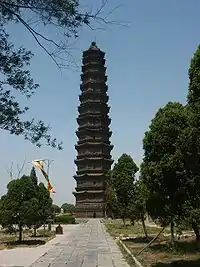
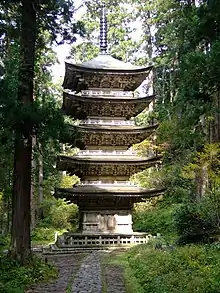 Five-story pagoda of Mount Haguro, Japan
Five-story pagoda of Mount Haguro, Japan Wooden three-story pagoda of Ichijō-ji in Japan, built in 1171
Wooden three-story pagoda of Ichijō-ji in Japan, built in 1171 Yingde pagoda, Qingyuan, Guangdong Province, China, from Johan Nieuhof (1618–1672); Jean-Baptiste Le Carpentier (1606 – c. 1670): L'ambassade de la Compagnie Orientale des Provinces Unies vers l'Empereur de la Chine, 1665
Yingde pagoda, Qingyuan, Guangdong Province, China, from Johan Nieuhof (1618–1672); Jean-Baptiste Le Carpentier (1606 – c. 1670): L'ambassade de la Compagnie Orientale des Provinces Unies vers l'Empereur de la Chine, 1665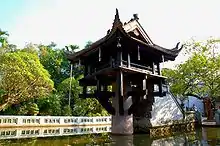
 The nine-story Xumi Pagoda, Hebei, China, built in 636
The nine-story Xumi Pagoda, Hebei, China, built in 636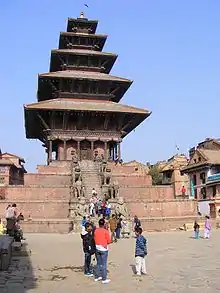

 The Bombardier Pagoda at the Indianapolis Motor Speedway
The Bombardier Pagoda at the Indianapolis Motor Speedway Shwedagon Pagoda located in Yangon, Myanmar. The whole structure is coated with 60 tons of pure gold
Shwedagon Pagoda located in Yangon, Myanmar. The whole structure is coated with 60 tons of pure gold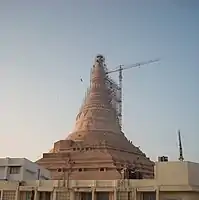 Pagoda Mumbai
Pagoda Mumbai
 Peace Pagoda - Sri Lanka
Peace Pagoda - Sri Lanka The Sun and Moon Pagodas lighted at night and reflected in Lake Shanhu in November 2017.
The Sun and Moon Pagodas lighted at night and reflected in Lake Shanhu in November 2017.
See also
- Architecture of the Song Dynasty
- Cetiya
- Chaitya
- Chinese architecture
- Ta - Chinese pagodas
- Gongbei – Chinese Muslim mausoleum with pagoda-style architecture
- Tō – Japanese pagodas
- List of pagodas in Beijing
Notes
- "The Origin of Pagodas". China.org.cn. 19 September 2002. Retrieved 23 January 2017.
- The Evolution of Indian Stupa Architecture in East Asia. Eric Stratton. New Delhi, Vedams, 2002, viii, ISBN 81-7936-006-7
- Pagoda at the Encyclopædia Britannica
- Architecture and Building. W.T. Comstock. 1896. p. 245.
- Steinhardt, 387.
- Chinese Origin of the Term Pagoda: Liang Sicheng's Proposed Etymology Authors: David Robbins Tien Publication: Acta Orientalia, volume 77 (2016),pp 133-144 David Robbins Tien, Gerald Leonard Cohen Publication: Arts, Languages and Philosophy Faculty Research & Creative Works DownloadTien, D. R., & Cohen, G. L. (2017) http://scholarsmine.mst.edu/artlan_phil_facwork. David Robbins Tien. Comments on Etymology, October 2014, Vol.44, no. 1, pp. 2–6.
- Random House Unabridged Dictionary, Second Edition. Random House, New York, 1993.
- Hobson-Jobson: The Anglo-Indian Dictionary by Henry Yule & Arthur Coke Burnell, first printed 1896, reprinted by Wordsworth Editions, 1996, p. 291. Online Etymology Dictionary by Douglas Harper, s.v. pagoda, at http://www.etymonline.com/ (Accessed 29 April 2016)
- A World History of Architecture. Michael W. Fazio, Marian Moffett, Lawrence Wodehouse. Published 2003. McGraw-Hill Professional. ISBN 0-07-141751-6.
- The Impact of Buddhism on Chinese Material Culture. John Kieschnick. Published 2003. Princeton University Press. ISBN 0-691-09676-7.
- Benn, 62.
- The Impact of Buddhism on Chinese Material Culture By John Kieschnick. Published 2003. Princeton University Press. ISBN 0-691-09676-7. p. 83
- The Impact of Buddhism on Chinese Material Culture By John Kieschnick. Published 2003. Princeton University Press ISBN 0-691-09676-7. p. 84
- Brook, 7.
- Hymes, 30.
- The Impact of Buddhism on Chinese Material Culture. John Kieschnick. Published 2003. Princeton University Press. ISBN 0-691-09676-7. page 83
- The Impact of Buddhism on Chinese Material Culture. John Kieschnick. Published 2003. Princeton University Press. ISBN 0-691-09676-7. page 84
- Terry, T. Philip (1914). Terry's Japanese Empire. Houghton Mifflin. p. 257.
- Christel, Pascal (2020). Splendour of Buddhism in Burma: A Journey to the Golden Land. Partridge Publishing Singapore.
- Spacey, John. Japan Talk https://www.japan-talk.com/jt/new/temple-architecture. Retrieved 7 January 2021. Missing or empty
|title=(help) - Chihara, Daigorō (1996). Hindu-Buddhist Architecture in Southeast Asia. BRILL. p. 28. ISBN 90-04-10512-3.
- Steinhardt, 383.
- Loewe (1968), 133.
- "Indianapolis 500 Traditions :: Indianapolis 500". 1 May 2008. Archived from the original on 1 May 2008.
References
- Benn, Charles (2002). China's Golden Age: Everyday Life in the Tang Dynasty. Oxford: Oxford University Press. ISBN 0-19-517665-0.
- Brook, Timothy. (1998). The Confusions of Pleasure: Commerce and Culture in Ming China. Berkeley: University of California Press. ISBN 0-520-22154-0
- Fazio, Michael W., Moffett, Marian and Wodehouse, Lawrence. A World History of Architecture. Published 2003. McGraw-Hill Professional. ISBN 0-07-141751-6.
- Fu, Xinian. (2002). "The Three Kingdoms, Western and Eastern Jin, and Northern and Southern Dynasties," in Chinese Architecture, 61–90. Edited by Nancy S. Steinhardt. New Haven: Yale University Press. ISBN 0-300-09559-7.
- Govinda, A. B. Psycho-cosmic symbolism of the Buddhist stupa. 1976, Emeryville, California. Dharma Publications.
- Hymes, Robert P. (1986). Statesmen and Gentlemen: The Elite of Fu-Chou, Chiang-Hsi, in Northern and Southern Sung. Cambridge: Cambridge University Press. ISBN 0-521-30631-0.
- Kieschnick, John. The Impact of Buddhism on Chinese Material Culture. Published 2003. Princeton University Press . ISBN 0-691-09676-7.
- Loewe, Michael. (1968). Everyday Life in Early Imperial China during the Han Period 202 BC–AD 220. London: B.T. Batsford Ltd.; New York: G.P. Putnam's Sons.
- Steinhardt, Nancy Shatzman (1997). Liao Architecture. Honolulu: University of Hawaii Press.
External links
| Wikimedia Commons has media related to Pagodas in China. |
- Oriental architecture.com
- Culzean Pagoda (Monkey House) - the only stone built pagoda in Britain
- "Why so few Japanese pagodas have ever fallen down" (The Economist)
- Chinese pagoda gallery (211 pics)
- The Bei-Hai (Beijing), The Flower Pagoda (Guangdong), The Great Gander Pagoda (Xian), The White Pagoda (Liaoyang)
- The Songyue Pagoda at China.org.cn
- Structure of Pagodas, including the underground palace, base, body and steeple, at China.org.cn
- The Herbert Offen Research Collection of the Phillips Library at the Peabody Essex Museum